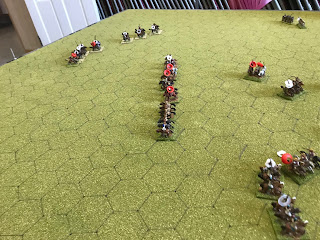This is a play test of a new rule set due out in December written by Alvaro Erize from the US.
We have had a couple of games previously but this one had a greater familiarity with the rules after re watching a video of the game here.
This game pitches a Roman supply convoy against marauding Gauls trying to intercept it. The Romans have a coupe of units of Gallic allies hanging around.
The first part involves scouting until all of the scouts are locked. Light units send out 2 scouts, one of which is a dummy. Those familiar with Chain of Command will be familiar with this mechanism. This picture shows all of the scouts locked. The dice record the number of movement action each scout has made. This can affect the starting fatigue number when units are placed on the table so take care how far they move.
Units are then placed on the table alternatively depending on where the scouts are.
The final units are placed on the table.
First blood to the Gallic raiders who have targeted the Gauls allied to the Romans.
In this game the active player gets 3 actions including the usual move, fire, melee, rest etc. Some of these generate fatigue others don't. After the players first action he must say if he intends doing another. If he does his opponent gets the chance to react with one action.
This unit of archers supporting their Roman allies has, for example, five fatigues already having performed 2 actions. They have been fired at which also generates fatigue. As fatigue increases effectiveness reduces accordingly.
These are the lads attacking the archers.
Unit of 8 legionaries takes its first casualty having formed close order and advanced to the cover of the hedge.
At the end of each turn all of the action dice are removed but any units that have not used all of their actions automatically rest removing the fatigue accordingly. For example a unit with 4 fatigue that has only used one action will drop to 2 fatigue.
The convoy advances as archers come out to meet them in support.
A Roman unit also heads out to support the convoys approach
The archers fire.
Behind the main building the Gallic allies are attacked by archers with devastating results, 4 casualties.
Another volley finishes them off as there is only one figure left the fatigue being double or higher the unit is removed.
The convoy makes its way towards safety.
The screen of archers takes more casualties.
The Gauls fail to dislodge the Romans from behind the hedge.
The Romans win initiative and switch to open order allowing them to move faster and gain the safety of the large house with the suppies
The Roman/Gallic casualties.
The Gauls only lose 5 figures!
Despite the disparity in casualties the Romans succeeded in saving their supplies so a victory to them.
We will be checking how we used the rules and apply any mistakes when we play another game next week.
These seem to be a very nice set of rules and i can see this system being developed into other periods in the future.
Cheers
Mick












































































